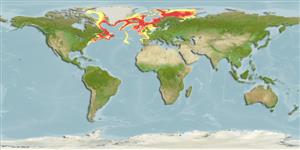Environment: milieu / climate zone / rango de profundidad / distribution range
Ecología
marino demersal; oceanodromo (Ref. 51243); rango de profundidad 50 - 2000 m (Ref. 4705). Temperate; 79°N - 36°N, 77°W - 55°E
Northwestern Atlantic: southwestern Greenland and Labrador in Canada to Virginia in USA (Ref. 7251); Northeastern Atlantic: Bay of Biscay to Spitsbergen, Barents Sea, Iceland and eastern Greenland.
Length at first maturity / Tamaño / Peso / Age
Madurez: Lm 122.0, range 135 - ? cm
Max length : 470 cm TL macho / no sexado; (Ref. 7251); 300.0 cm TL (female); peso máximo publicado: 320.0 kg (Ref. 7251); edad máxima reportada: 50 años (Ref. 173)
Espinas dorsales (total) : 0; Radios blandos dorsales (total) : 98 - 110; Espinas anales: 0; Radios blandos anales: 73 - 85. Uniformly dark brown or black; young marbled or spotted with paler marks (Ref. 4705).
Body shape (shape guide): fusiform / normal.
Adults are benthic but occasionally pelagic (Ref. 4705). Feed mainly on other fishes (cod, haddock, pogge, sand-eels, herring, capelin), but also takes cephalopods, large crustaceans and other bottom-living animals. Batch spawner (Ref. 51846). Growth rate varies according to density, competition and availability of food. Slow growth rate and late onset of sexual maturity, halibut populations can be seriously affected by overfishing (Ref. 35388). Utilized fresh, dried or salted, smoked and frozen; can be steamed, fried, broiled, boiled, microwaved and baked (Ref. 9988). Also Ref. 58426.
Males reach sexual maturity at 7-8 years and females at 10-11 years. Spawning happens from December to April, near the bottom (300 to 700 m), at temperatures between 5 and 7°. Egg size 3.0-3.8, larval size at hatching 6.5 mm (Ref. 4705).
Vinnikov, K.A., R.C. Thomson and T.A. Munroe, 2018. Revised classification of the righteye flounders (Teleostei: Pleuronectidae) based on multilocus phylogeny with complete taxon sampling. Molecular phylogenetics and evolution, 125:147-162. (Ref. 122998)
IUCN Red List Status (Ref. 130435: Version 2025-1)
Threat to humans
Harmless
Human uses
Pesquerías: comercial; Acuicultura: experimental; pesca deportiva: si; Acuario: Acuarios públicos
Herramientas
Special reports
Download XML
Fuentes de Internet
Estimates based on models
Preferred temperature (Referencia
123201): 0.4 - 7.9, mean 3.4 °C (based on 1760 cells).
Phylogenetic diversity index (Referencia
82804): PD
50 = 0.7500 [Uniqueness, from 0.5 = low to 2.0 = high].
Bayesian length-weight: a=0.00550 (0.00401 - 0.00754), b=3.17 (3.09 - 3.25), in cm total length, based on LWR estimates for this species (Ref.
93245).
Nivel trófico (Referencia
69278): 4.0 ±0.5 se; based on diet studies.
Resiliencia (Referencia
120179): Muy bajo, población duplicada en un tiempo mínimo superior a 14 años (tmax=30; tm=10; K=0.02-0.2; Fec=1,300,000; also Musick et al. 2000 (Ref.
36717)).
Prior r = 0.27, 95% CL = 0.18 - 0.40, Based on 1 full stock assessment.
Fishing Vulnerability (Ref.
59153): Very high vulnerability (88 of 100).
🛈
Climate Vulnerability (Ref.
125649): Moderate vulnerability (43 of 100).
🛈
Nutrients (Ref.
124155): Calcium = 5.62 [1.90, 13.84] mg/100g; Iron = 0.178 [0.067, 0.495] mg/100g; Protein = 17.9 [16.0, 20.4] %; Omega3 = 0.35 [0.14, 0.90] g/100g; Selenium = 57.8 [19.5, 148.9] μg/100g; VitaminA = 7.93 [1.78, 32.76] μg/100g; Zinc = 0.387 [0.168, 0.655] mg/100g (wet weight); based on
nutrient studies.
